How to Croatia: An Overview of the Croatian Education System
December 7, 2022 – In today’s edition of How to Croatia, we are bringing an overview of the Croatian education system from early childhood to higher education.
The Croatian education system starts with childcare or formally with the preschool year. While the earliest that children can be enrolled is at six months in jaslice (Croatian term for nursery), the mandatory aspect of education typically starts at the beginning of the year before the start of primary school at the age of 6 and lasts until the age of 14. Secondary and higher education in Croatia are accessible to all but not mandatory. There are both public and private education institutions at every level. The academic year in Croatia usually starts in early September for primary and secondary education or October for higher education. It ends in early June for primary and secondary levels, while at the higher education level, it sometimes extends to the second half of July.
Childcare and preschool
As mentioned above, the earliest a child can be enrolled in childcare is at six months old, though that depends on the specific institution. In most places, local authorities will have a system of benefits or subsidies for parents, especially those with more than one child. English is taught in most Croatian kindergartens, while international kindergartens with programmes in foreign languages (German, French, Italian, Spanish) can, for now, only be found in Zagreb and Split. Preschool education is mandatory and free of charge for all children in the year just before they start primary school.
Primary school
Children start primary school at 7 or 6 if they turn seven before the 31st of March of the following year (that same academic year). Primary school is split into two levels and lasts eight years. Grades 1-4 are oriented towards class teaching, where there is one main teacher who covers the base subjects (Croatian, mathematics, art, social), while subject teachers for foreign languages, computer science, and religion come in to teach their specialised subjects usually for one or two classes per week.
The second level of primary education, grades 5-8, is oriented toward subject teaching. The pupils are still organised into classes and allocated a teacher responsible for class admin, but specialised subject teachers teach all the subjects. Subjects like geography, history, and biology are introduced in grade 5, while chemistry and physics are introduced in grade 7.
Specific inclusive programmes are set up for children with learning disabilities, which are either adjusted or individualised to fit their needs.
Secondary education
The secondary level of education typically starts at the age of 14, while the duration depends on the type of programme. There are two main types in Croatia, grammar schools and vocational schools.
Grammar schools are further specialised into those with a general or classical programme, those which focus more on natural subjects, or those with a focus on languages. Programmes in all grammar schools typically last four years and enable the students to pursue higher education.
Vocational schools, on the other hand, equip students for a specific profession. The duration depends on the programme, where programmes for trades typically last between one and three years, hospitality and tourism programmes last three years, economy and computer science last four years, and nursing school lasts five years. After graduating from a vocational school, students can either pursue higher education or enter the job market with the qualification they acquire.
When it comes to primary and secondary programmes in foreign languages, just as is the case with childcare, international schools exist in Zagreb and Split.
Higher education
One of the best aspects of life in Croatia is that higher education is free for all. The public education system of universities, colleges, and polytechnics is very well developed and follows the European Higher Education framework based on the Bologna Process. The requirements for enrollment depend on the specific programmes, but the base is a points system that accounts for the student’s final grades during all years of secondary education and a state exam at the end. All students who wish to study at public higher education institutions must pass the mandatory subjects – Croatian, English, and mathematics, and they can choose to sit for the supplementary subjects which might be required or bear extra credit for specific fields (e.g., biology and chemistry for medicine). When it comes to programmes in foreign languages, alongside language studies, several universities have started offering public programmes in English, like those in Zagreb, Split, and Rijeka. A vast network of private higher education institutions also exists in Croatia, offering various programmes.
Inclusive special education
Croatia has a developed inclusive education system for children with developmental and learning difficulties, starting with childcare. Depending on the extent of their needs, they might be enrolled in mainstream classes where they are approached with programmes tailored specifically for them or have a learning assistant assigned. On the other hand, they might be directed toward a specialised school which, in some cases, they can attend until the age of twenty-one.
Art and music
Another aspect of education regulated by law is official art (dance) and music education. Primary music school lasts six years, and children from the age of 7 can be enrolled. Secondary music school lasts four years and can be taken as the only programme of secondary education. More often than not, though, students attend music school parallel to another secondary school. Primary dance school lasts four years, and so does secondary dance school, which can also serve as the only secondary programme.
For more, make sure to check out our dedicated Lifestyle section.
Govt Amendments To Improve Preschool Education Standards
ZAGREB, 31 March 2022 - Ensuring equal opportunities for all children and including them in the education system, increasing the number of children included and improving the quality of the education system is the aim of the final draft bill on preschool education.
The recommended amendments the government sent to parliament on Thursday are part of the education reform within the framework of the National Recovery and Resilience Plan (NPOO), with Science and Education Minister Radovan Fuchs saying the bill by no means revokes the National Pedagogical Standard.
In order to ensure that all children aged three to six can attend preschool education by 2030, it is necessary to secure additional capacities and infrastructure with an investment of HRK 1.6 billion from the NPOO, which should enhance the capacity of preschool institutions by 22,500 places.
The bill proposes a national network of children's kindergartens in an effort to improve planning regarding the construction and reconstruction of preschool institutions and to reduce the differences in development, thus enabling the inclusion of more children in early and preschool education.
The bill enables the possibility for elementary school teachers to be employed in kindergartens.
Having in mind regional differences, the bill envisages the possibility of funding from the state budget to complete investments for EU projects to build kindergartens in less developed areas.
It also provides for the possibility to secure funding to maintain the fiscal sustainability of kindergartens established by local government units based on criteria set by the government.
Final draft bill on the Croatian Science Foundation
In an effort to boost the research and innovation potential and implement programmes planned under the NPOO, the government sent a final draft bill on the Croatian Science Foundation to parliament.
The foundation was established with the aim of developing and promoting science and technological development by ensuring support to research of strategic interest for Croatia, however, the incumbent legislation is outdated, inflexible and does not correspond to the research demands in Croatia or Europe, Minister Fuchs explained.
"In an effort to increase the efficiency and functionality of investments in science projects and enable the implementation of programmes set by the NPOO, the bill defines only the framework to grant funds while the actual programmes will be defined by the Foundation's general acts," Fuchs added.
Politics: For more, check out our politics section.
Croatia Spends HRK 4.7 Billions on R&D in 2020
ZAGREB, 1 Nov 2021 - A total of HRK 4.7 billion was spent on research and development (R&D) in Croatia in 2020, which is 6% more than in 2019, and there were 25,217 persons employed in R&D, which is 5.7% more than in 2019, show data from the Croatian Bureau of Statistics.
Of the total funds for R&D, the largest amount was spent in the business sector, 47.9% or HRK 2.3 billion, followed by higher education with 32.2% or HRK 1.5 billion, while the least was spent in the government and private non-profit sector, 19.9% or HRK 941.9 million.
Labour costs accounted for the largest share of expenditures for R&D, 64.4% or more than HRK 3 billion.
Other current costs account for 24.2% or HRK 1.1 billion of total expenditures, while capital expenditures account for only 11.4% or HRK 540.4 million.
As for funds for R&D for all sectors, the largest part was financed by units with internal funds, 41.2% or HRK 1.9 billion. Central and local government follows with 33.8% or HRK 1.6 billion.
An analysis by sectors shows that enterprises mostly finance R&D with internal funds (72.7%), while the government and private non-profit sector (63.6%) and higher education (62%) are mostly financed by the central and local government.
(€1 = HRK 7.5)
Make sure to check out our dedicated business section.
Croatia's First Enogastronomy Study Programme: Students to Learn About Pairing Indigenous Wine and Food
May 25, 2021 - As reported by Večernji list, the Polytechnic of Požega will from the next academic year offer Croatia's first enogastronomy study programme.
The first study programme in the field of biotechnical sciences is focused on the quality and health of food and beverages, primarily in the hospitality and tourism sector.
At the Polytechnic, they point out that the current development of gastronomy in Croatia must not be left to chance and that the need for the education of experts in this area is becoming increasingly important.
There are now three national gastronomy study programmes in Croatia, but this is the only study programme of enogastronomy, which means that the science and study of wine will play a significant role. But, the key difference is that this is the only STEM study programme of its kind.
"Unlike the other two study programmes, which are predominantly economic and in which marketing and communication dominate, 70 percent of our courses revolve around cooking and only 30 percent are marketing and management," explains doc.dr.sc. Berislav Andrlić, Vice Dean for Development of the Polytechnic.
Although the enrollment quota in the first year has been reduced to 30 full-time students who will study at the expense of the Ministry of Science and Education in Požega, due to the specifics of the study, students from all potential tourist areas of Croatia are expected. A smaller number of students is fitting because cooking involves professional practice with a chef, for which work in small groups is ideal, but the program content includes a number of courses related to indigenous dishes from all parts of Croatia, from Dalmatia and Istria to Slavonia.
"We believe that such a study in Požega is needed for two reasons. The first is the resources we have in the environment, and the second is the needs of the labor market. We have conducted a survey among businessmen, hotels owners, restaurants, and family farms on the Adriatic and on the continent, and more than 70 percent said that they needed such food and beverage managers, restaurant and hotel managers, i.e. people who will know how to create menus and do guest management, and at the same time know how to produce food. So, it offers a combination of both occupations, both sales, and food production, which is not the case with other programmes that are mostly based only on sales," Andrlić points out.
Upon completion of this programme, students will acquire a Bachelor's in engineer food technology, majoring in enogastronomy, which is an innovation compared to other similar faculties where they were bachelors of economics. Potential employers will be all economic entities that are primarily engaged in tourism, i.e. food production on the one hand and tourist catering on the other. With students who complete the study of enogastronomy in Požega, they will get both of these functions in one person.
For more on made in Croatia, follow TCN's dedicated page.
BREAKING FREE NEWS: Incredible Freddie Mercury Tribute by Čakovec Students
May 20, 2021 – Brilliant Queen and Freddie Mercury Tribute by Čakovec students boldly challenges prejudice, oppression and expectations.
When people think of Čakovec in northern Croatia, usually they're not thinking of a shockingly, progressive place. But, perhaps that's just why high school students of Josip Slavenski Gymnasium decided on this move. Certainly, the graduation photo of the school's 4 E class boldly counters all expectations.
Instead of the usual fun, frivolity and throwing of hats, the students decided for their end-of-term picture to challenge, provoke and confound everyone. The result is absolutely fantastic, 'breaking free' of all conformity.
In the Freddie Mercury tribute photo, the Čakovec students are all dressed as the iconic Queen frontman, as seen in the video to the band's unforgettable 'I Want To Break Free' single. In 1984, when the song was originally released, it caused quite the controversy.
Queen and Freddie Mercury 'I Want to Break Free'
In Europe, the release was well-received, the video adored and the song went to the top of the charts. But, in the USA, it was a different story.
Queen had not considerably troubled the charts in America since their breakthrough 1970s single 'Bohemian Rhapsody'. But, in 1984, the band released in the U.S. the American version of their multi-platinum 'Greatest Hits' album. A hit! Then, they followed it with a new single, 'Radio Gaga'. Again, a hit! After over a decade of releasing music, Queen were finally on the brink of breaking the most lucrative music market in the world.
So, what did they do? For their next song, 'I Want To Break Free', the band decided to appear entirely 'in drag', as women, in the video. Although transvestitism is completely unrelated to homosexuality, perhaps the least intelligent members of society presumed this to be the idea of the band's singer, Freddie Mercury, who was gay. Not so. The idea for the video actually came from Queen drummer Roger Taylor.
American music television simply didn't understand the video. They refused to screen it. When they did, American audiences were either mystified or horrified. Well, this is a country that once elected Donald Trump for president. The response to this brilliant Freddie Mercury Tribute photo from the students of Čakovec might be comparable, in the least progressive sections of society. You know, the places where people still point to the sky when a plane passes. Or where the music of Queen is considered 'new'. As, perhaps, is electricity.
4 E Josip Slavenski Gymnasium, Čakovec, Freddie Mercury tribute
And yet, with this outrageous Freddie Mercury Tribute, these Čakovec students have proved themselves to be the best of the future generation. Bold, confrontational, committed and outright funny. In the Freddie Mercury tribute, they stand in front of the banner for the Festival of Alternative Čakovec. It's a deliberately inclusive event, intended to draw all sections of society. Anyone challenging their sense of fun must simply be regarded as the most miserable, moany and backward of all among us.
Just as the band Queen confounded some with their 1984 release, so too today will these Čakovec students with their Freddie Mercury Tribute. Luckily, there are many more young progressive people in Čakovec and Croatia - and Queen fans - than there are miserable, moany voices. Bravo class 4 E Josip Slavenski Gymnasium, Čakovec!
Croatian Mathematical Society (HMD) Has a New President, Dr. Vesna Županović
May 20, 2021 - Earlier in May, the Croatian Mathematical Society (HMD) elected a new president, Dr. Vesna Županović.
As Vedran Pavlić wrote for TCN back in 2016, Croatian students were then better in math than in 2011. Fantastic results were also accomplished in 2018 when Croatian students scored medals at the mathematical olympiad. Good results didn't go amiss in 2020, and initiatives for promoting science (such as the one of the Local History Museum in the central town of Ogulin that introduced kindergarten kids with quantum physics), appear all over the country.
Scientists do have their own professional associations, representing them and with more engaging, less engaging, with bigger, or smaller success, work on the promotion of their respective fields. Mathematicians are no exception, and it's worth noting that the Croatian Mathematical Society (HMD) recently has a new president, Dr. Vesna Županović. Faculty of Electrical Engineering and Computing (FER) at the University of Zagreb reported on its website, an online assembly of HMD voted that Županović be the new president on May 14, replacing dr. Hrvoje Kraljević was the president for the past 14 years.
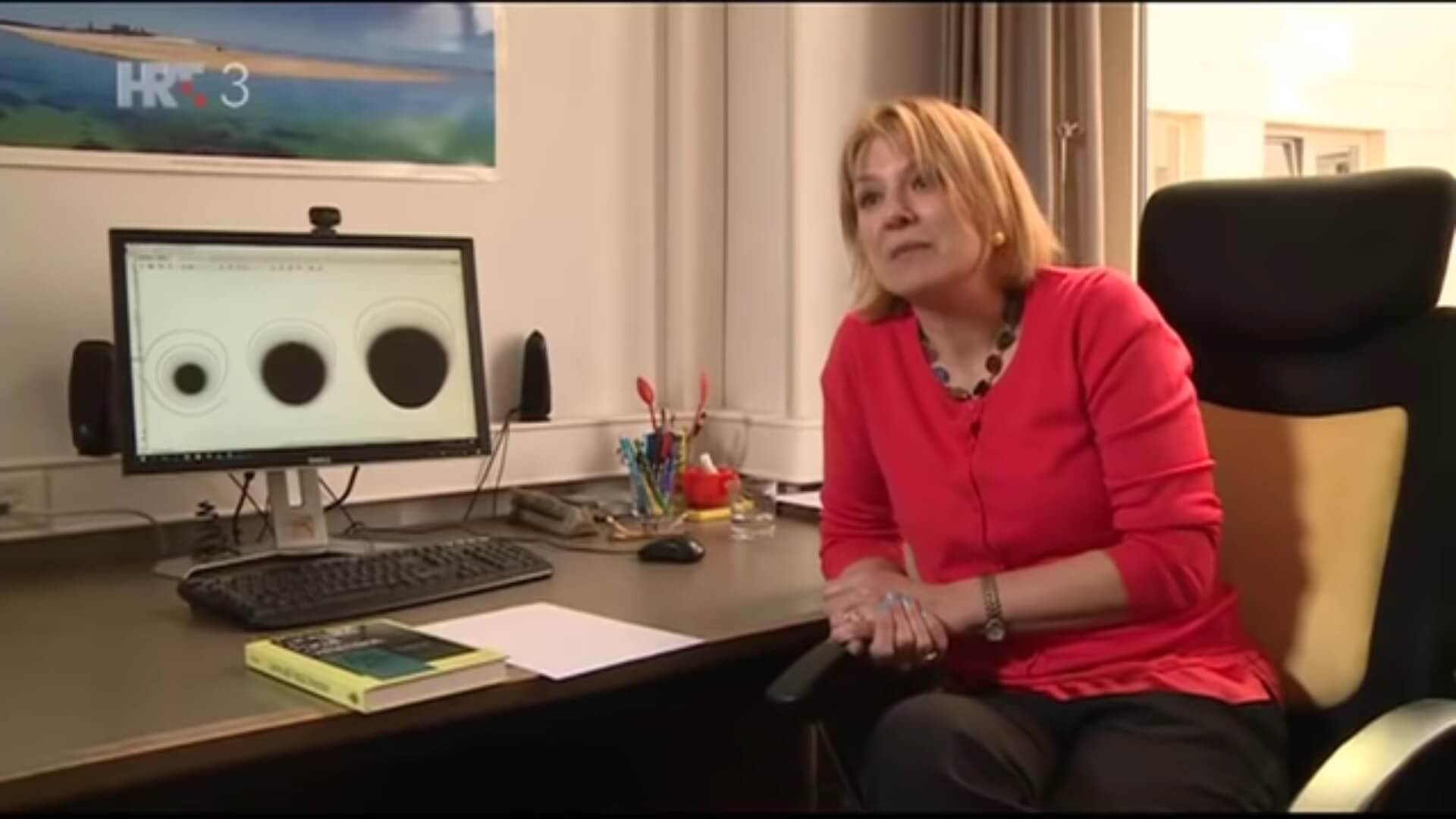
Vesna Županović, screenshot / Treći element
Apart from her new function, Županović is the professor at FER's department for applied mathematics.
Being the faculty that expects excellent mathematical knowledge, FER is quite happy with this decision of HMD, and they also explained the importance of the aforementioned society.
„HMD goal is to enhance and promote mathematical sciences, math education on all levels, math applying in other fields, as well as enhancing the social status of mathematicians in general“, said FER on their website while congratulating. Županović on being elected.
They added that HMD has five departments: education, scientific, engineering, professional, and student department, along with a youth section that gathers pupils on lower levels of the education system. Publishing scientific and professional magazines and books on math is in the domain of the organization too.
Before being president, Dr. Županović was the Head of the Engineering department on HMD. Born in Split in 1965, she graduated from Mathematical Gymnasium in Split and went on to Zagreb to study math at the Faculty of Science (PMF), University of Zagreb. Her competence in math includes Nonlinear equations, Bifurcation, Fractals, Limit-cycles, Nonlinear dynamical systems, and Spirals.
Croatian Mathematical Society stated on its website that they are organizing conferences, math competitions, participation in math Olympics and other international contests, summer schools, and more.
In 1994, HMD also started a Mathematical Foundation For Science with a goal to award young scientists for their contribution. The receiver of the award can't be more than 35 years old, and concluding with 2015; five awards have been given in total since the first award in 1996.
Learn more about Croatian inventions & discoveries: from Tesla to Rimac on our TC page.
For more about science in Croatia, follow TCN's dedicated page.
Best Faculty at Zagreb University: Faculty of Agriculture Scores Highest in NTU Ranking
May 11, 2021 -The oldest university in Croatia is the one in Zagreb, and the best faculty at Zagreb University is the Faculty of Agriculture, according to the NTU global ranking of 800 universities worldwide.
The quality of Zagreb University, according to the global NTU ranking conducted by the National Taiwan University, is in decline. On the list of 800 Universities worldwide, Zagreb University was ranked 478th best in the world, and in recent years it was levitating between 551st and 600th place. But, as Srednja.hr reports, the overall decline of quality has an exception on that list, and it's thanks to the Faculty of Agriculture.
The Faculty is ranked to be the best at Zagreb University, and the area of agriculture on the global list is ranked between 301st and 350th place. That is the ranking of the area, but also under the criteria of research interest, the ranking is even better, 87th place, thus making it the only thing at Zagreb University to be in the top 100 on the list.
„Even though it's the oldest human occupation, agriculture today is light years away from what our grandparents know. Agriculture is part of the STEM area (‘science, technology, engineering & mathematics), and it's actually highly technological. There are several reasons why this sector so is fastly modernized. For starters, the production of food and raw ingredients to produce food is the most important human activity that will always have demand. To keep up the step with the increasing number of population, less and less arable surfaced and the increasing living standards, agriculture had to modernize significantly, and introduce newest technologies“, writes Srednja.hr.
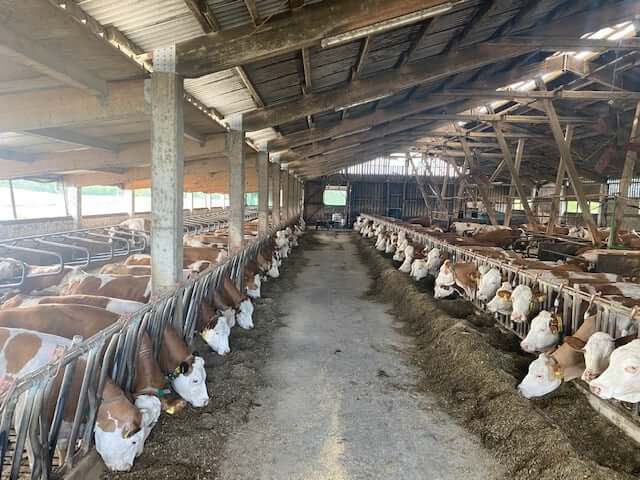 © Sveučilište u Zagrebu Agronomski fakultet
© Sveučilište u Zagrebu Agronomski fakultet
The Agriculture Faculty in Zagreb was founded in 1919. As the Faculty's official website reports, they have over 450 employees today who are highly motivated to pass their knowledge to around 2,500 students, which they consider their greatest value that they add to society.
„By connecting with foreign universities, both from Europe and worldwide, we have international cooperation in both teaching and scientific research area, and student mobility. Successful participation in bilateral and multilateral research programs, exchanges of students, young scientists, and university lecturers, as well as securing scholarships contribute to the visibility and recognition of the Faculty on all levels“, says the Agriculture Faculty.
The Faculty's personnel annually publishes 280 scientific papers, and in the last decade, 160 active research projects are ongoing with 75% of investments coming from domestic sources and the rest from international ones. Scholarships supports, and rewards for the best students are secured through the trust fund the Faculty has.
„It's less known that the Agriculture Faculty is declared a Scientific Centre of Excellence CroP-BioDiv (for biodiversity and molecular plant breeding). It is one of the 10 scientific centers in the STEM area declared in the Republic of Croatia. CroP-BioDiv is a research network of top scientists from all over Croatia directed to the transmission of highly sophisticated knowledge and technologies“, writes Faculty's website concluding their institution is directed towards future with sustainability, quality, research encouragement, scientific excellence, and cooperation with the Croatian economy, as key strategic goals.
As Zagreb is a popular ERASMUS destination among European students because of cheap drinks, rich and vibrant party scene, The Agriculture Faculty shows that apart from partying, the Croatian capital is a place to get some actual learning done. And on a pretty high standard no less, at least when it comes to agriculture which serves as a role model to the rest of the poorly ranked University.
Agriculture is about food, and you can learn more about Croatian food (specifically, vegan and vegetarian options) on our TC page.
For more about education in Croatia, follow TCN's dedicated page.
Human Rights in Croatia 2020 Overview: Serbs, Roma People, and LGBTQ Hate Speech Targets
April 16, 2021- The Human Rights in Croatia 2020 Overview report by Human rights house Zagreb shows hate speech and poor living conditions of Serb returnees and Roma people still being problematic. The judicial system and the lack of a legal frame for civil society development remain problematic too.
In a battle against the Coronavirus, many agree and fear that human rights were put in second place, triggering the debate of security vs. liberty and justification of limiting movement, work, etc.
But human rights and their respect in Croatia was an issue, long before Covid-19. As Jutarnji List warns, the situation is not good.
Croatia doesn't have a defined politics of making a supportive environment for the civic society development. Citizen participation in decision making is still relatively weak and the judicial system is a special problem," says Jutarnji List referring to the new report by Human Rights House in Zagreb titled „Human Rights in Croatia: 2020 Overview“.
Regarding the judicial issue, a specific example can be found in the ever-controversial "Za Dom Spremni!"(For the Homeland Ready) salute which is recognised as a fascist salute and punishable by law but it's tolerated as part of the song „Čavoglave“ by Marko Perković Thompson and can frequently be heard during his concerts both by the singer and the audience.
„Circumstance that the salute is part of the song doesn't change the fact that it's an ustasha (Croatian fascist) salute that symbolizes criminal Naci-fascist ideology and is the violation of article 39 of Croatian constitution that prohibits any call or encouragement on national, racial or religious hatred or any form of intolerance“, continues Jutarnji List.
Still present in public space, hate speech in Croatia is also very alive on the Internet, with the Serb LGBTQ community and Roma people being the prime targets. As Jutarnji reports, last year's research show this as well as the lack of appropriate response.
„Children and adolescences do not learn enough about human rights, equality, and solidarity, given that civil education is conducted as one of six intercourse themes in elementary and high-schools. Such approach to civil education does not secure enough time in the curriculum for quality development of civil competence of pupils“, concluded for Jutarnji List Human Rights House in Zagreb.
Educational segregation for Roma people, isolated Serb returnees migrant treatment controversies, C+ grade for LGBTQ travelers
The article also adds that Roma people in Croatia are still facing many obstacles in achieving their rights, which include employment, access to services, and adequate living standards, and there is still segregation in the education system too.
Furthermore, many Serb returnees live in undeveloped rural areas, which are isolated and offer poor living conditions. Additionally, they still struggle to achieve their asset rights, and their possession is still tangible to devastation.

Pixabay
When it comes to LGBTQ rights, as TCN previously reported, Croatia „has an index of 188 points and a grade C+ from most safe to highest dangerous places (A to F), placing it among the first third of the best countries in the world in terms of LGBTQ+ safety“. There are controversies regarding the migrants' treatment on which we recently reported on too.
Learn more about Croatia's global rankings and many more fun facts about the country on our TC page.
For more about politics in Croatia, follow TCN's dedicated page.
Faculty of Economics University of Zagreb Celebrates 100 Years
ZAGREB December 5, 2020 – With over 9000 students currently enrolled, the Faculty of Economics University of Zagreb is the largest faculty in Croatia. In 2020, this internationally renowned institution celebrates its 100th birthday, so TCN decided to take a closer look.
Every other student you meet in Croatia seems to study economy. It makes you wonder where they all go to after their studies are complete. Are there really so many positions for economists in Croatia?
In 2020, the Faculty of Economics University of Zagreb celebrates its 100th birthday. The long list of its famous former students gives a clue to where all the Croatian economists go – the tourism sector, diplomacy and international relations, business, politics and government.
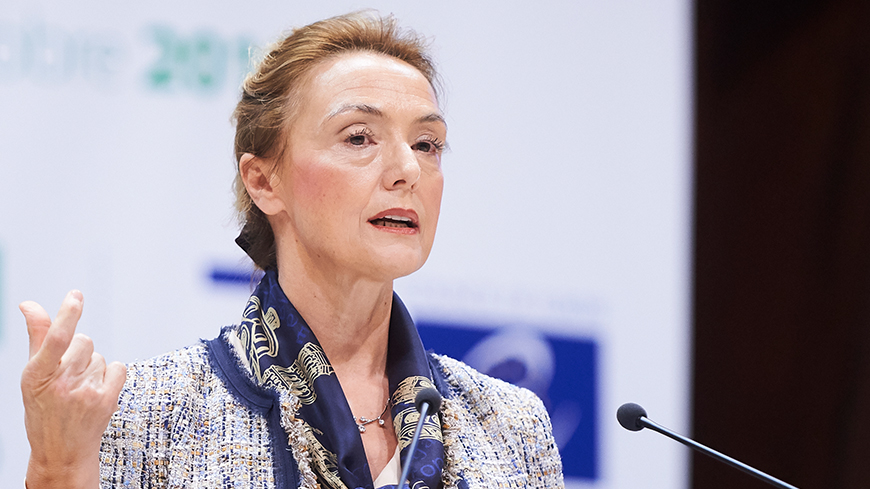 Marija Pejčinović Burić, a graduate of the Faculty of Economics of the University of Zagreb and the current Secretary General of the Council of Europe. After graduating, like Savka Dabčević-Kučar, she became o doctor of economics and before taking her current position served as Croatia's Deputy Prime Minister and Minister of Foreign and European Affairs © Council of Europe
Marija Pejčinović Burić, a graduate of the Faculty of Economics of the University of Zagreb and the current Secretary General of the Council of Europe. After graduating, like Savka Dabčević-Kučar, she became o doctor of economics and before taking her current position served as Croatia's Deputy Prime Minister and Minister of Foreign and European Affairs © Council of Europe
Graduates of the Faculty of Economics University of Zagreb have served as mayors of Zagreb and Split, Deputy Prime Minister of Croatia, Minister of Finance, Minister of the Economy, Secretary-General of the Council of Europe, Governers of the Croatian National Bank, Vice-President of the UN World Food Council, President of the Croatian Football Association, Minister of Environmental and Nature Protection, special advisors to the President of Croatia and countless university professors, including several former rectors of the University of Zagreb. Within its graduate professors, it has produced no less than 19 full members of the prestigious Croatian Academy of Sciences and Arts, more than any other single institution in the country.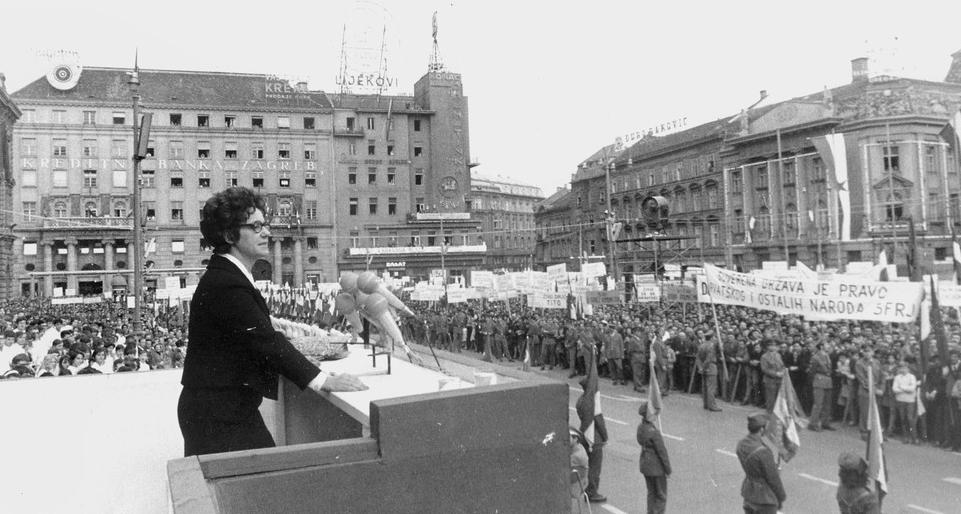 Savka Dabčević-Kučar, a graduate of the Faculty of Economics of the University of Zagreb. Born on Korčula, she became an anti-fascist in World War II, joining the partisans after her brother was beaten by fascists. After graduating, she continued to study at the faculty and became one of the first doctors of economics in Croatia, raising eyebrows by choosing to write her doctorate dissertation about a non-Marxist economic theorist (Englishman John Maynard Keynes). She became a professor at the faculty in the 1950s and despite her great advances in political life, remained a committed teacher at the faculty until 1971. In 1967, she was elected President of the Socialist Republic of Croatia. In 1969, she moved to an even more important position - that of president of the Central Committee of the League of Communists of Croatia. She was the first woman in Europe to be appointed head of government of a political entity and the first female in Croatia to hold an office equivalent to a head of government. In this picture, she addressed supporters on Ban Jelacic Square Zagreb during the movement called the Croatian Spring, which called for greater autonomy for Croatia. At the address, thousands cheered her as “Savka, queen of the Croats”. For her pivotal role in the movement, she was removed from her positions and public life and retired. She returned to politics in 1990 upon the collapse of communism in Europe and during the Croatian war of independence was one of the few politicians who visited the front lines of battle in Slavonia, Petrinja, Pokupski and the Dalmatian hinterland
Savka Dabčević-Kučar, a graduate of the Faculty of Economics of the University of Zagreb. Born on Korčula, she became an anti-fascist in World War II, joining the partisans after her brother was beaten by fascists. After graduating, she continued to study at the faculty and became one of the first doctors of economics in Croatia, raising eyebrows by choosing to write her doctorate dissertation about a non-Marxist economic theorist (Englishman John Maynard Keynes). She became a professor at the faculty in the 1950s and despite her great advances in political life, remained a committed teacher at the faculty until 1971. In 1967, she was elected President of the Socialist Republic of Croatia. In 1969, she moved to an even more important position - that of president of the Central Committee of the League of Communists of Croatia. She was the first woman in Europe to be appointed head of government of a political entity and the first female in Croatia to hold an office equivalent to a head of government. In this picture, she addressed supporters on Ban Jelacic Square Zagreb during the movement called the Croatian Spring, which called for greater autonomy for Croatia. At the address, thousands cheered her as “Savka, queen of the Croats”. For her pivotal role in the movement, she was removed from her positions and public life and retired. She returned to politics in 1990 upon the collapse of communism in Europe and during the Croatian war of independence was one of the few politicians who visited the front lines of battle in Slavonia, Petrinja, Pokupski and the Dalmatian hinterland
The Faculty of Economics University of Zagreb is the largest faculty in the country. Over its 100 year history, it has established itself as an internationally respected institution. Today, it has around 9000 persons enrolled, caters for international students with some courses in English and has produced over 86, 000 graduates, including 856 doctors of science.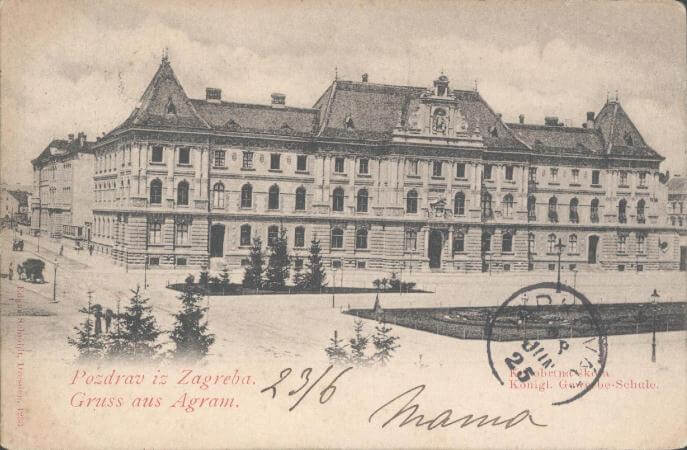 In its infancy, students of the College of Trade and Transport were taught at the Technical College, which is today the Museum of Arts and Crafts in Zagreb © National and University Library in Zagreb
In its infancy, students of the College of Trade and Transport were taught at the Technical College, which is today the Museum of Arts and Crafts in Zagreb © National and University Library in Zagreb
The history of the Faculty of Economics University of Zagreb starts with the opening in 1920 of its forerunner, the Zagreb College of Trade and Transport. Its purpose was to educate in the areas of banking, domestic and international trade, transport, consular services, insurance and the education of teachers. Its courses lasted three years and it proved so popular that in the academic year 1923/24, some 1,125 students were enrolled.
The institution held college status until 1925 when Stjepan Radić became the Minister of Education. It must have been unusual for Radić to find himself as part of the government of the Kingdom of Serbs, Croats and Slovenes, the state which preceded the Kingdom of Yugoslavia. Today, Radić is best remembered as a politician outspoken in his advocacy of autonomy for Croatia. Before his appointment to the government, he had always done so in opposition. Indeed, he had been imprisoned several times for his views, which were proclaimed loudly in his writings or in person (he was a gifted public speaker). As recently as March 1925 he had been in prison but, when the political party of which he was a member officially recognised the monarchy and the state constitution, he was freed. In a remarkable turnaround, before the year's end, he was a minister in the government.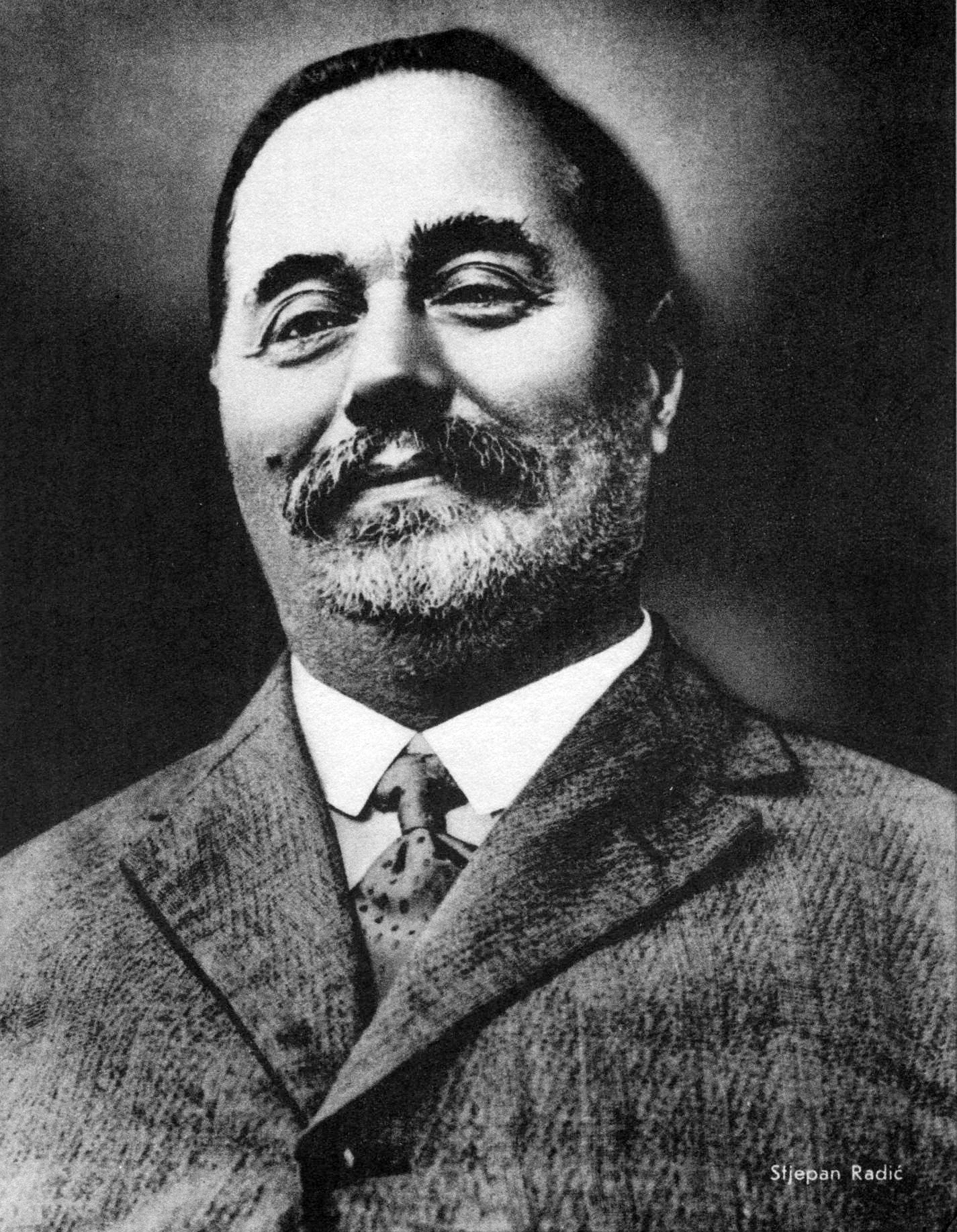 Stjepan Radić, pictured in the 1920s © public domain. In 1895 Radić was sent to prison for the public burning of the Hungarian flag in Zagreb – alongside Antun Dabčević, the father of Savka Dabčević-Kučar.
Stjepan Radić, pictured in the 1920s © public domain. In 1895 Radić was sent to prison for the public burning of the Hungarian flag in Zagreb – alongside Antun Dabčević, the father of Savka Dabčević-Kučar.
Stjepan Radić's desire for Croatian autonomy was not born from the ideals of the political class of Zagreb. The ninth of eleven children, born to a peasant family in a small village on the banks of the Sava river, just north of Sisak, Radić was very much a representative of the people whence he came. To him (and others in his family – his brother and nephew also being prominent politicians), education had the most important role to play in emancipation. He had lived in poverty in order to complete his own - after being banned from university-level educational institutions throughout the whole of the Austro-Hungarian empire for his protests against the state, he travelled penniless to Russia, France and Switzerland to complete his studies. In the latter, finance was one of his chosen subjects.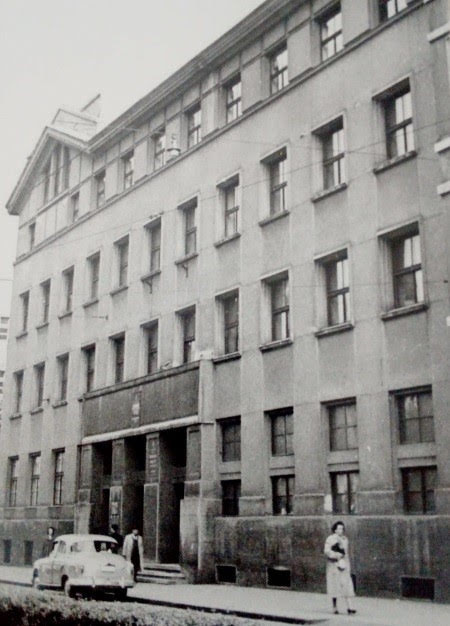 The first dedicated building of the Higher School of Economics and Commerce was located on the corner of Bauerova and Zvonirmirova © Faculty of Economics University of Zagreb
The first dedicated building of the Higher School of Economics and Commerce was located on the corner of Bauerova and Zvonirmirova © Faculty of Economics University of Zagreb
Under Radić's spell in office, the Zagreb College of Trade and Transport became the Higher School of Economics and Commerce. Its courses extended to four years, it attained university status. With no building designated to the increasingly popular institution, students had sometimes been taught at the Technical College (today's Museum of Arts and Crafts) and in parts of what is now the Mimara Museum. A dedicated home for the faculty was authorised and its construction started in 1927. Classes began at the faculty, located on the corner of Bauerova and Zvonimirova, in 1928, but within the decade the institution had outgrown its home and a plot of land in Svetice was acquired in order to build a new, larger facility. Its construction was interrupted by the Second World War and students would end up being taught on the Bauerova and Zvonimirova site all the way up to 1952.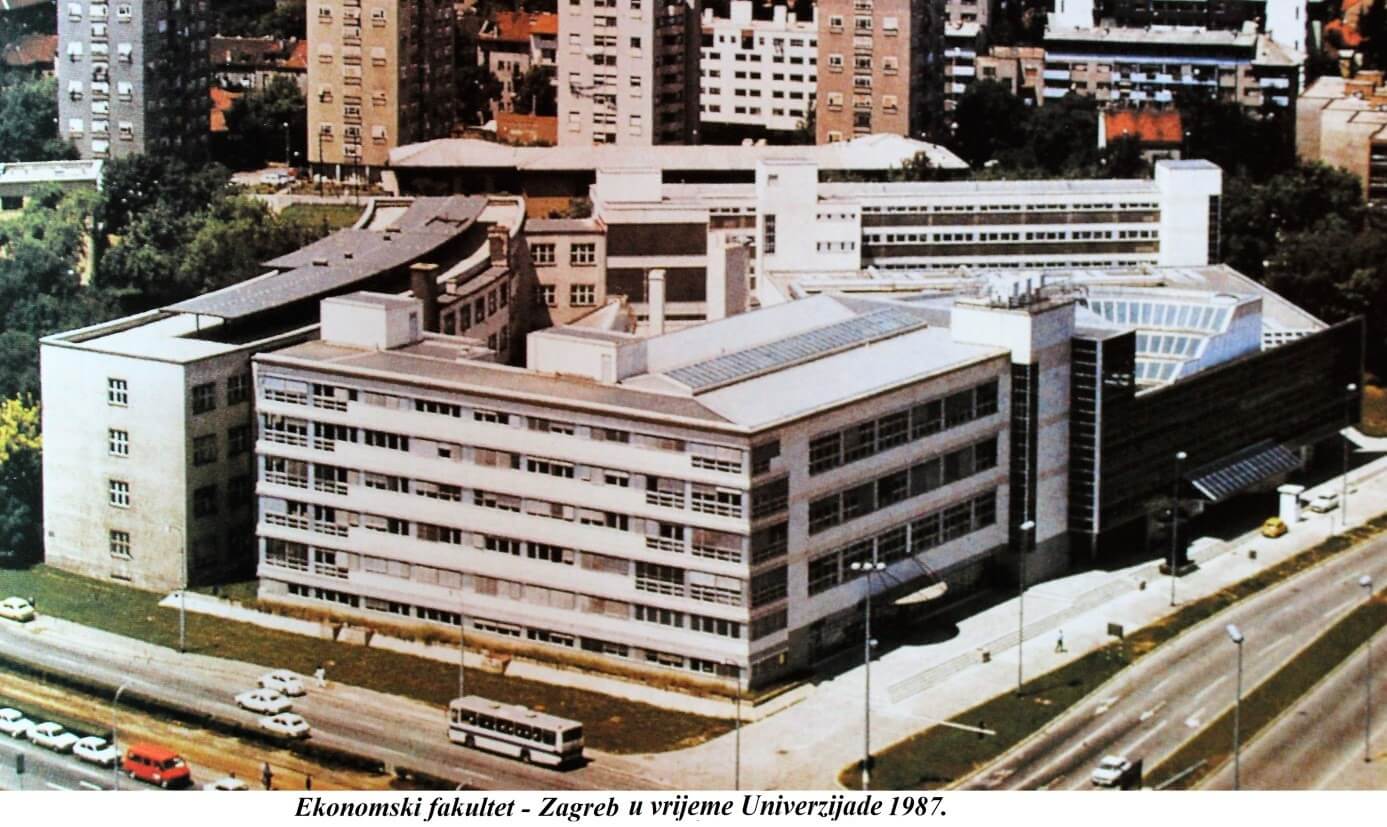 The faculty's modern building, pictured in 1987. Today, the faculty has 17 departments - Finance, Demography, Economic Theory, Business Economics, Informatics, Macroeconomics and Economic Development, Marketing, Mathematics, International Economics, Business in Foreign Languages, Organization and Management, Law, Accounting, Statistics, Trade and International Business, Tourism, Physical Education and Health © Faculty of Economics University of Zagreb
The faculty's modern building, pictured in 1987. Today, the faculty has 17 departments - Finance, Demography, Economic Theory, Business Economics, Informatics, Macroeconomics and Economic Development, Marketing, Mathematics, International Economics, Business in Foreign Languages, Organization and Management, Law, Accounting, Statistics, Trade and International Business, Tourism, Physical Education and Health © Faculty of Economics University of Zagreb
In 1947, the Higher School of Economics and Commerce became the Faculty of Economics University of Zagreb. In 1952, the faculty officially moved to the new site in Svetice. In 1968 it expanded once more when it merged with the 12-year-old College of Economics. Since then, the building at Svetice has received major upgrades and further facilities of the faculty can now also be found at the university campus in Borongaj, in Varaždin, in Koprivnica and in Bjelovar. After a century of existence, the Faculty of Economics University of Zagreb's longstanding difficulties to meet the popularity of its courses with the space available are now over. Not only can they accommodate every Croatian economy student who makes the grade, but they are also able to offer places to some of the best international students. It would surely come as no surprise if they are still educating the future elites of business, banking, finance and politics in another 100 years.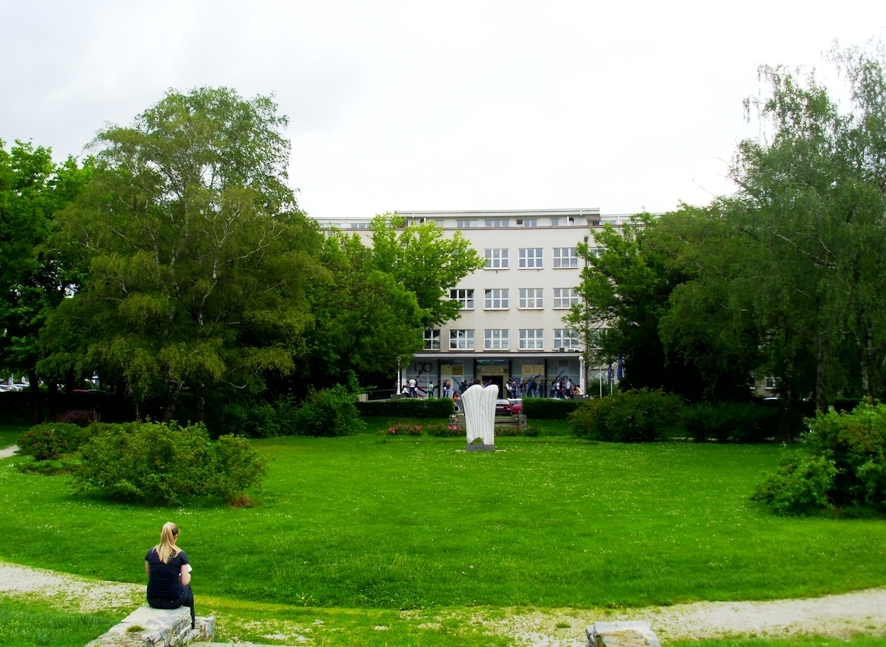
The Faculty of Economics University of Zagreb site in Svetice, as seen from its garden © Wolf - Pidgeon
Slavonia Students Spot 300 Spelling Mistakes In Names of Public Places
November 21, 2020 - How difficult is it to learn Croatian? Slavonia students from one high school learned it's really not so easy for people to correctly use their own language
How difficult is it to learn Croatian? Well, it's pretty difficult. Croatians know this best of all and will be reasonably impressed if you make any advances in trying to speak their language. A professor of linguistics from Zagreb University once told this writer that to be able to regard yourself as wholly proficient in the Croatian language, you would have to study it to no less than university level. Naturally, not every speaker of Croatian has done so.
Slavonia students from a high school in Slavonski Brod were recently tasked with looking for mistakes in the use of Croatian language in public places. So complex is the Croatian language, spelling and grammar mistakes are commonplace. The teacher assigning the task, Vesna Nosić from Matija Mesić high school, was no doubt confident her students would uncover some mistakes. However, the grand total of 300 spelling and grammar mistakes the Slavonia students found is possibly more than was bargained for. Particularly as those found were all assigned to public places.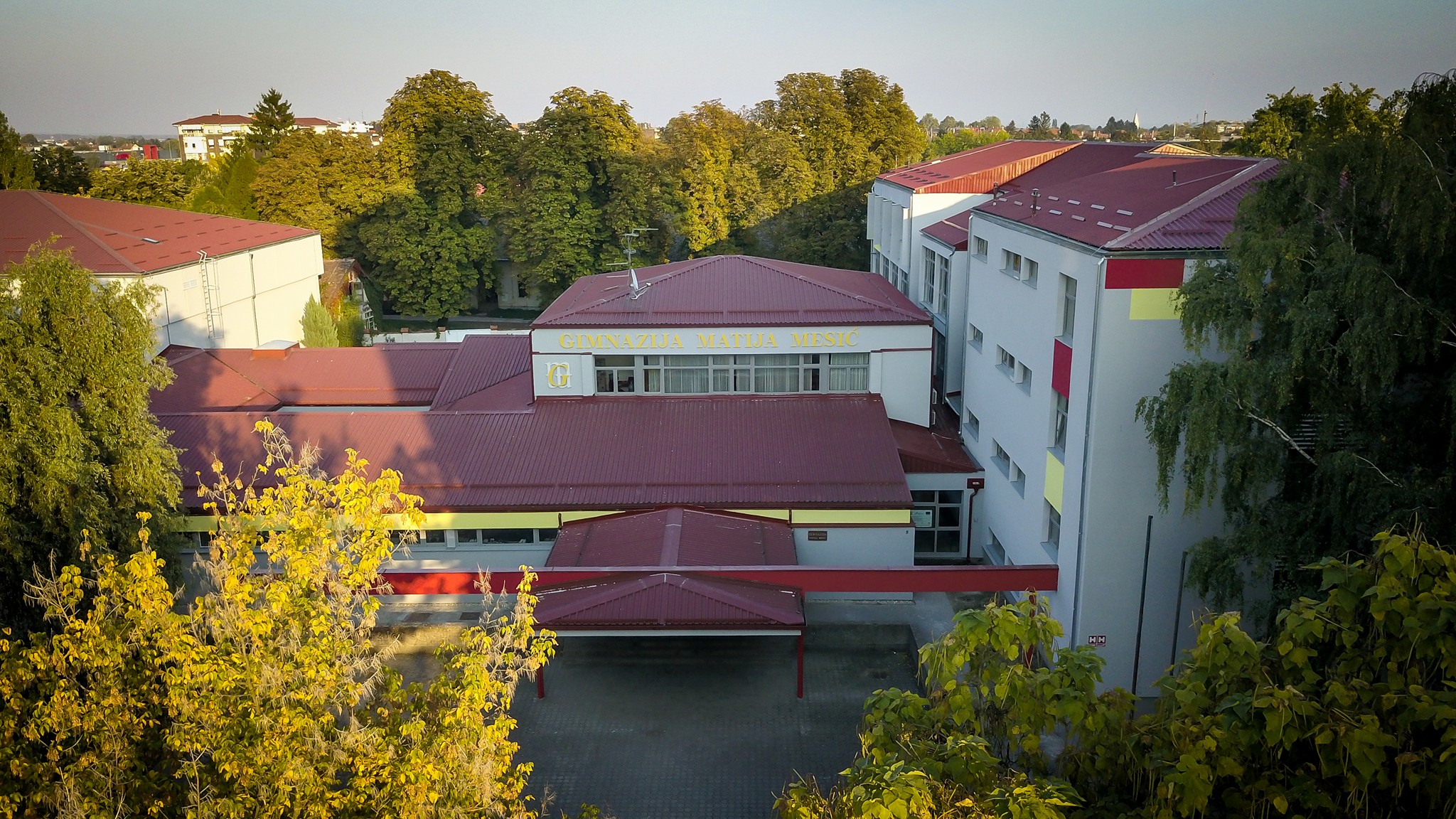 Matija Mesić high school in Slavonski Brod, where Slavonia students made their findings © Matija Mesić high school
Matija Mesić high school in Slavonski Brod, where Slavonia students made their findings © Matija Mesić high school
The misspelling or incorrect translation of food items on a restaurant or tavern menu is a regular cause of amusement in Croatia. But, the mistitling of public places - streets, squares, companies, monuments, traffic signs and even schools – is perhaps more surprising. These are places you walk past every day.
The Slavonia students were given the high bar of the official standards of Croatian language set by the Institute of Croatian Language and Linguistics. Their teacher, Vesna Nosić, has published their findings in the popular science journal Hrvatski jezik (Croatian language), which is published by the institute. Croatian language is something of a national obsession in Croatia, its acceptance as the official language very closely linked to the country's struggle for autonomy. For most of its history, the lands of modern-day Croatia were controlled by empires for whom Croatian was not their language. The use of foreign tongues has been imposed on the population of Croatia for centuries.
The most common mistakes made in the Croatian language are related to the incorrect use of the sounds ć and č, đ and dž. The letters here come from Gaj's Latin alphabet, devised by Croatian linguist Ljudevit Gaj in 1835. It is the Latin script used across the region in which to write the similar languages of Bosnian, Croatian, Serbian, and Montenegrin (in Bosnia, Serbia and Montenegro, the Cyrillic alphabet is used as well as Gaj's Latin alphabet).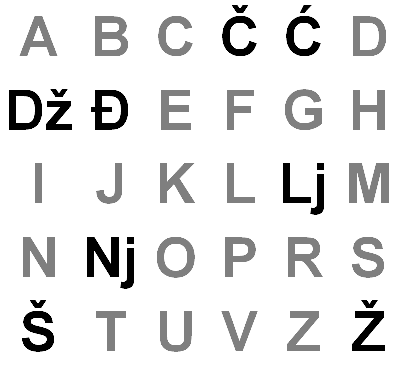
The contemporary version of Gaj's Latin alphabet (it originally contained Dj, which was replaced by đ. This alphabet ihe easiest part of learning Croatian - within 15 minutes, almost anyone can correctly pronounce all Croatian words by using this. In comparison to the Latin alphabet used by English speakers, the letters q,w,x,y are omitted. Instead, we get the additional č, ć, dž, đ, lj, nj, š and ž. Looks difficult? It isn't. Almost all of these sounds exist within the English language. Except for lj which, to English speakers, is torturously missing some kind of vowel © Albatalad
Mistakes between the ć and č or đ and dž sounds are understandable if you can pronounce Gaj's Latin alphabet. And anyone can. The easiest part of learning Croatian is Gaj's Latin alphabet – all of the sounds exist within the English language, all of the letters are always pronounced in exactly the same way (unlike English). The difference in sound between ć and č or đ and dž in spoken Croatian is difficult to perceive if you are not a native speaker (often, even if you are!)
Some of the mistakes found by the Slavonia students are perhaps more forgivable – the standard of Croatian their comparisons was made against is rigid. Thus, pekarna (bakery) instead of pekarnica, or dućan (shop) instead of trgovina were classed as mistakes, but are actually in everyday use on streets across Croatia.
Other mistakes found relate to grammar, spelling and the misuse of upper case or lower case lettering. For instance, Ulica Pavleka Miškina should be written Ulica Pavleka Miškine (the word ending changes to denote it is the street of Pavlek Miškina), Crkva Gospe od brze pomoći, should be crkva Gospe od Brze Pomoći; Muzej Brodskog Posavlja should be Muzej brodskoga Posavlja and Šetalište Braće Radić should be Šetalište braće Radića (denoting it is the promenade of the Radić brothers).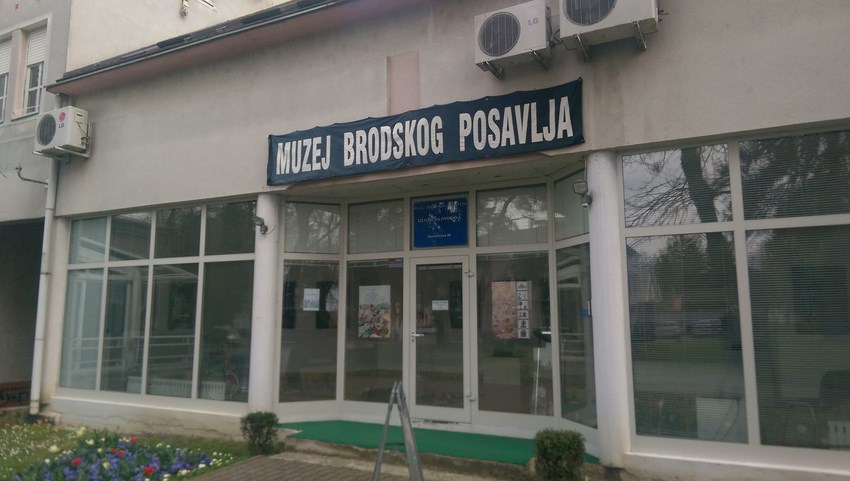 Not sure which words should be in upper case or lower case in Croatian? Write everything in upper case - problem solved! © Slavonski Brod Tourist Board
Not sure which words should be in upper case or lower case in Croatian? Write everything in upper case - problem solved! © Slavonski Brod Tourist Board
Sitting to one side and watching how others do something, judging them, then informing them they are doing it incorrectly is not the most pleasant way to occupy your time. However, for the purposes of this study, this not-uncommon activity in Croatia is exactly what was asked of the Slavonia students. However, as noted in today's coverage of this story in Index, there is a great saying in Croatian that serves as a response to any unwanted judgments coming from those on the sides - “clean up the trash in front of your own doorstep before you discuss that which lies in front of your neighbour's”. And, that's exactly what the Slavonia students did – and found out that the name of their own school was spelled wrong.


